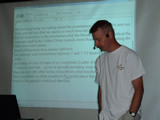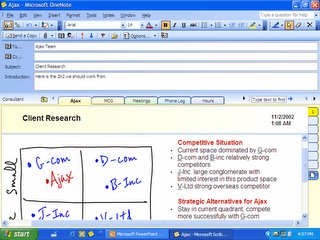What about technology do teachers need to know? For the past year I've been working in various ways on this question, and, well yes, I have long lists of answers. But those long lists are about competencies, and what matters more - at the start - are attitudes. Teachers need to accept both the technologies and the responsibilities that they, as educators, have to the future - and their students' needs. If this happens then they may seek out the tech knowledge they need, or, at least, be much more receptive to it.
So, after years of listening to educators speak about technology, here are my "attitude adjustments."
First,
educators need to stop thinking that "technology" is something separate from society and separate from their lives. After all, do we not describe human societies by their technology? We are different from ancient Greeks not in moral world-view or variations of government or even literature, but in how technology alters our interactions with, and perceptions of, the universe. Our technology is our world. To deny that is to deprive students of a key component of their education, and a whole vital set of life skills.
Second,
teachers need to stop mourn ing old technologies
ing old technologies. I am sorry, but catching the duck, pulling the feather, and cutting a perfect quill, need not be an essential part of the writing curriculum anymore. Nor does how to carefully unroll a sheepskin scroll need to be in the reading curriculum unless you are preparing children for their Bar/Bat Mitzvah. And, we could probably drop the lessons on how to look things up in a library card catalogue, in how to operate a slide rule, and how to use correction fluid properly when typing. Also, morse code no longer needs to be a graduation requirement. Notice that everything in this paragraph is "a technology." They were introduced into education at one point in time in response to changes in the world, and they have disappeared in response to other changes. The world works this way.
And to combine those ideas, they must realize that new ways to do things are not either "better" or "worse" - because that is a debate we could have for a millenium without

resolution - but simply different, and the way things work now. Bemoan the destruction of the scribes' art at the hands of Gutenberg all you want, but that is not an educationally valid reason to refuse to let your students read printed books.
Third,
educators must accept responsibility for changing knowledge. They are professionals, underpaid certainly, but professionals in perhaps the most important human occupation. Imagine your doctor saying, "I don't believe in MRIs or CT Scans, we'll open you up and look around." Or, "You may think there are different effects of medicines on different people, but I really haven't read those things." You would run out the door. But teachers and school administrators say the equivalent things all the time. Imagine the 1970 teacher saying, "I don't use pens in my classroom, they run out of ink sometimes and children lose them." Or, "I know there are other reading books but I've stuck to
McGuffey's Readers, they have always worked for me." You expect your phone not to depend on vacuum tubes anymore, and you like your airliner to use radar and automated landing signals

, and you don't go out in the morning expecting to crank-start your car. Should students expect anything less?
Fourth,
teachers must accept human differences. I realize that this is difficult for either American Republicans or New Labour in the UK, but different students need different things, and the best way to let that happen in a classroom (absent individual tutors) is technology. We need to fully understand that there are all kinds of different but effective ways to get information in, and get information out - not just "the authors intent" or "the old way." After all, Shakespeare wrote his plays to be performed before rowdy audiences of standing people who were talking, yelling, singing, sometimes throwing things - yet -
and this is true - I have seen teachers have students
read his plays! And you know what? Some students (not many in my experience, but some) really like it.
Fifth,
get over it. "I don't allow pencils in my classroom, one student stabbed another wit

h one once, and others write bad notes with them." "I don't allow books in my classroom, I had a student throw one once and another child was hurt. And last week a boy brought a book to class with bad words in it." "I won't let them use paper for math, it interferes with them memorizing their arithmetic facts." "I can't allow children to wear shoes in class, some students have more expensive shoes than others, and then jealousy starts." "I will not let students see each other in my classroom, I realized that some students were signalling to their friends." I have heard every one of these excuses from educators explaining why they can't let students use computers, or pocket PCs, or cell phones, or the internet, or calculators. And all they are, are excuses for faculty not willing to learn how to teach to, and for, a world different from the one they were born into.
- Ira Socol
 Technology is a leveler. Not strong enough to lift that weight? Use a winch or a lever. Not fit enough to walk ten miles to work every day? Drive your car. Memory not good enough to remember all your phone numbers and computer passwords? Write them down. Not enough time in your day to sweep your home and beat your rugs? Use a vacuum cleaner.
Technology is a leveler. Not strong enough to lift that weight? Use a winch or a lever. Not fit enough to walk ten miles to work every day? Drive your car. Memory not good enough to remember all your phone numbers and computer passwords? Write them down. Not enough time in your day to sweep your home and beat your rugs? Use a vacuum cleaner.












